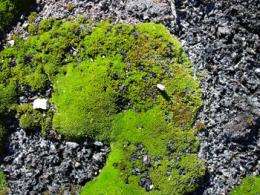July 6, 2012 weblog
Antarctic moss found able to survive due to ancient penguin colony guano

(Phys.org) -- Researchers studying moss in an elevated site in East Antarctica recently began wondering how it is that the fuzzy green plants are able to not just survive in the barren landscape, but to thrive. In that part of the continent, there isn’t much soil, just sand and rock; yet the moss, like virtually all other plants needs nutrients to survive, specifically nitrogen. To find out, they took a closer look at the material in which the moss grew and to their surprise found plenty of nutrients in it, including nitrogen.
The find of course aroused curiosity in the researchers so they looked closer at the nitrogen and found that it was nitrogen-15, an isotope that is commonly found in seabird excrement. This led them to look a little closer at the immediate environment which led to the discovery that the moss was actually growing on what used to be the site of a large penguin colony. The researchers found not just skeletons but the tiny pebbles that penguins use for building nests. As it turns out the area had been the site of a large colony of Adelie penguins that had vacated the premises some three to eight thousand years ago, leaving behind a small mountain of guano.
But how could moss today be living on bird dung left thousands of years ago? Turns out that because the environment in which the moss are living gets so cold and so dry, the guano stays nearly frozen all the time and the plants are actually freeze dried each winter, a state that would of course kill most plants. But not the varieties found in Antarctica. Instead the cycle forms the basis of a relationship that allows the plants to thrive thousands of years after the penguins left the site; and because the moss is able to live there, so too are other organisms such as insects and other small creatures. The moss will likely be able to endure for quite awhile as penguins tend to produce a lot of excrement as recent reports have indicated that modern penguin colonies create so much that it can be seen from space.
What’s also interesting is how the moss is able to survive being freeze dried every year. Further study will hopefully shed some light on which chemicals it produces to achieve such a feat, which could in turn help researchers in other sciences discover new ways to store food or medicine.
More information:
via BBC Nature
© 2012 Phys.Org

















